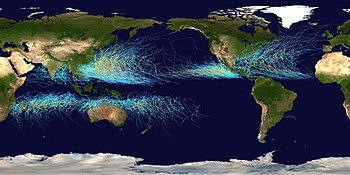24:
176:
73:
cause these cyclones to quickly fill up and decay as soon as they reach land at the eastern end of the basins, accounting for the easternmost edges of the storm tracks.
65:
travel. The storm tracks usually begin in the westernmost parts of
Atlantic and Pacific, where the large temperature contrasts between land and sea cause
217:
236:
161:
210:
241:
246:
203:
125:
120:
58:
76:
Storm tracks can shift position, causing important climatic patterns. As an example, during
31:
tracks between 1985 and 2005, indicating the areas where tropical cyclones usually develop
8:
95:
99:
23:
191:
62:
43:
28:
80:
the
Atlantic storm track shifts north causing droughts in Palestine, while during
187:
230:
183:
144:
Douglas Inman and Scott
Jenkins. "Climate Patterns in the Coastal Zone."
115:
17:
87:
Another example of a storm track is the circumpolar storm track in the
81:
77:
103:
88:
70:
50:
175:
66:
54:
39:
91:, however land-sea contrasts play no role in its formation.
148:
Springer
Science & Business Media, Nov 8, 2006. pg. 246
98:, storm tracks can be visualized by contouring its average
84:
it shifts south bringing heavy rains to the same region.
38:
are the relatively narrow zones in seas and oceans where
57:
have storm tracks along which most
Atlantic or Pacific
228:
211:
162:NOAA National Weather Service - Storm Tracks
218:
204:
69:to form, particularly in winter. Surface
22:
229:
170:
13:
14:
258:
155:
237:Synoptic meteorology and weather
174:
146:Encyclopedia of Coastal Science.
138:
1:
131:
190:. You can help Knowledge by
94:Given a grid point field of
7:
109:
10:
263:
169:
102:, after the data has been
15:
186:–related article is a
59:extratropical cyclones
32:
16:For the magazine, see
126:Extratropical cyclone
121:Tropical cyclogenesis
42:travel driven by the
26:
242:Tropical meteorology
96:geopotential height
100:standard deviation
33:
247:Meteorology stubs
199:
198:
63:tropical cyclones
254:
220:
213:
206:
178:
171:
149:
142:
44:prevailing winds
29:tropical cyclone
262:
261:
257:
256:
255:
253:
252:
251:
227:
226:
225:
224:
167:
158:
153:
152:
143:
139:
134:
112:
21:
12:
11:
5:
260:
250:
249:
244:
239:
223:
222:
215:
208:
200:
197:
196:
179:
165:
164:
157:
156:External links
154:
151:
150:
136:
135:
133:
130:
129:
128:
123:
118:
111:
108:
9:
6:
4:
3:
2:
259:
248:
245:
243:
240:
238:
235:
234:
232:
221:
216:
214:
209:
207:
202:
201:
195:
193:
189:
185:
180:
177:
173:
172:
168:
163:
160:
159:
147:
141:
137:
127:
124:
122:
119:
117:
114:
113:
107:
105:
101:
97:
92:
90:
85:
83:
79:
74:
72:
68:
64:
60:
56:
52:
47:
45:
41:
37:
36:Storm tracks
30:
25:
19:
192:expanding it
181:
166:
145:
140:
93:
86:
75:
48:
35:
34:
184:meteorology
116:Storm train
18:Storm Track
231:Categories
132:References
106:filtered.
104:band-pass
89:Antarctic
110:See also
71:friction
67:cyclones
51:Atlantic
82:El Niño
78:La Niña
55:Pacific
27:Global
40:storms
182:This
188:stub
53:and
49:The
61:or
46:.
233::
219:e
212:t
205:v
194:.
20:.
Text is available under the Creative Commons Attribution-ShareAlike License. Additional terms may apply.
